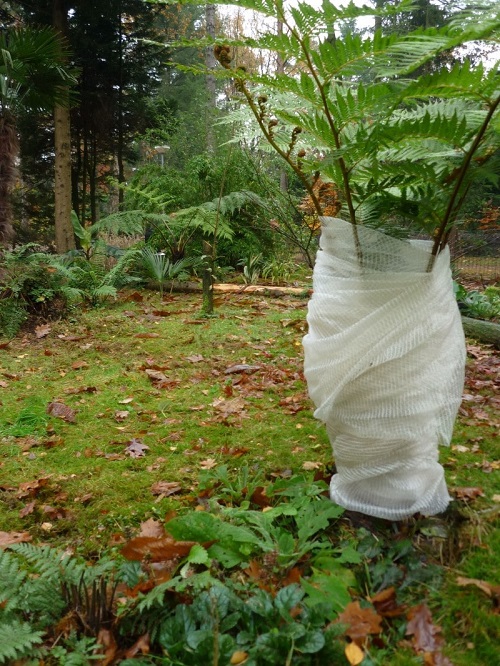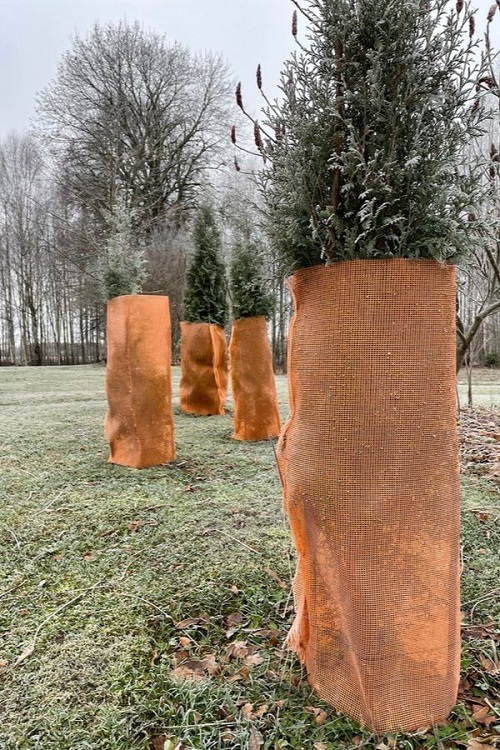Discover Why Wrapping Tree Trunks With Old Blankets is such a great idea and how it can help your garden!
Winter is finally here, and so is the time for wrapping holiday gifts! But apart from gifts, there is something else that needs wrapping. Any guesses? Well, we are talking about tree trunks. Let’s see why this is such a great idea!
Why Wrap Tree Trunks During Winter?
1. Protection Against Sunscald
The sun peeking out from between the fog and mist on some days while being “missing in action” on the next is a common phenomenon as the weather gets colder. This might seem insignificant, but it impacts trees more than you think.
On days when the sun is high, it warms the thin bark of newly planted trees, causing increased cellular activity. If the temperature suddenly drops over the following days due to the absence of direct sun, it kills the active cells inside, resulting in injury. This process is known as “sunscald“. It presents as discolored, sunken bark that starts peeling off as flakes, exposing the dead tissues beneath.
Wrapping your newly planted trees with old blankets helps protect them from this sunscalding.
2. It Deter Pests
Would you want wood-boring insect species nesting on your beautiful trees? Or pesky squirrels, deer, and rabbits snacking on the tender bark or roots? Of course not!
Tiny creatures like insects can damage the inner bark, which is responsible for the proper circulation of water and nutrients throughout the plant. They can also eat through the cambium, the part of the trunk responsible for the growth of newer bark. However, tree wrapping during this time can deter these pests as well.
3. Protects Against Wind and Frost Damage

Though many deciduous trees can easily spring back from the snow and cold after winter, most evergreens and even deciduous ones in northern climates benefit from blanket tree wrapping.
Most importantly, if you have sensitive trees or ones with a thin-bark texture, such as maple, crabapple, ashes, linden, and honeylocusts, you must wrap them up snugly. These are susceptible to fluctuating temperatures and dry, cold winds that can lead to desiccation and frost damage without proper protection, especially when they are young.
4. No Frost Cracks
Another benefit of wrapping tree trunks is preventing frost cracks. These vertical cracks in the bark can occur when the tree’s trunk experiences rapid temperature changes.
During the day, the trunk may warm up in the sun, causing its cells to expand. When temperatures plummet, the trunk cools quickly at night, and the cells contract. This repeated expansion and contraction can stress the bark, leading to frost cracks.
These cracks are often found on the southwest side of a tree but can also affect branches. They are several feet long and may develop at the site of a previous wound or branch stub.
Frost cracks are not usually fatal to a tree but allow disease organisms to enter. Plus, they don’t really go; they may heal in the summer but reopen again in the winter.
How to Wrap Tree Trunks with Old Blankets

The ideal time to wrap blankets around tree trunks is late fall before the first hard frost arrives. Depending on your location and climate, this typically occurs between late October and early December.
Traditional methods aren’t as good because burlap can often be bulky or messy, and you need to make holes for air movement with plastic wraps.
Why not save yourself from all that extra trouble? Just find an old blanket and wrap it around your tree! There’s only one rule—be gentle and don’t damage the branches of younger and shorter ones. Too tight, and it will cause physical damage to your tree!
Another option is to insert three wooden stakes into the ground to form a triangle around your tree and fasten your blanket over the stakes. Ensure that the blanket is snug against the tree so that no insects or pests can get in through your protective barrier.
Be careful of the blanket material as well. Choosing one with coarse, heavy, unbreathable fabric may cut off proper air and water circulation within the trunk. It may also allow insects to nest under the fabric. We don’t want that, do we? Go with horticulture fleece or old blankets, and avoid thick, non-woven ones.
Tips to Remember When Tree Wrapping
- The ideal time for tree-wrapping is between the holidays. Remember to pull out those old blankets before Thanksgiving and keep your trees wrapped between Thanksgiving and Easter.
- Once wrapped, remove it in early spring for better results. Use horticulture fleece if you’re doing it longer until all frost dangers are passed. For the short term, tree wrapping with a blanket is fine.
- Do not choke your trees when wrapping them. You do not want to cut off circulation in your young trees, so be gentle when wrapping the blankets.
- Do not skimp on plant care. Tree wrapping won’t cause problems if you’ve been caring for and monitoring your plants regularly.
- Check the wrap periodically to see if it remains breathable and pest-free.
- Remember to wrap the base of the trunk as well to protect it from ground-level temperature fluctuations, and mulching is also important for better results.




awesome